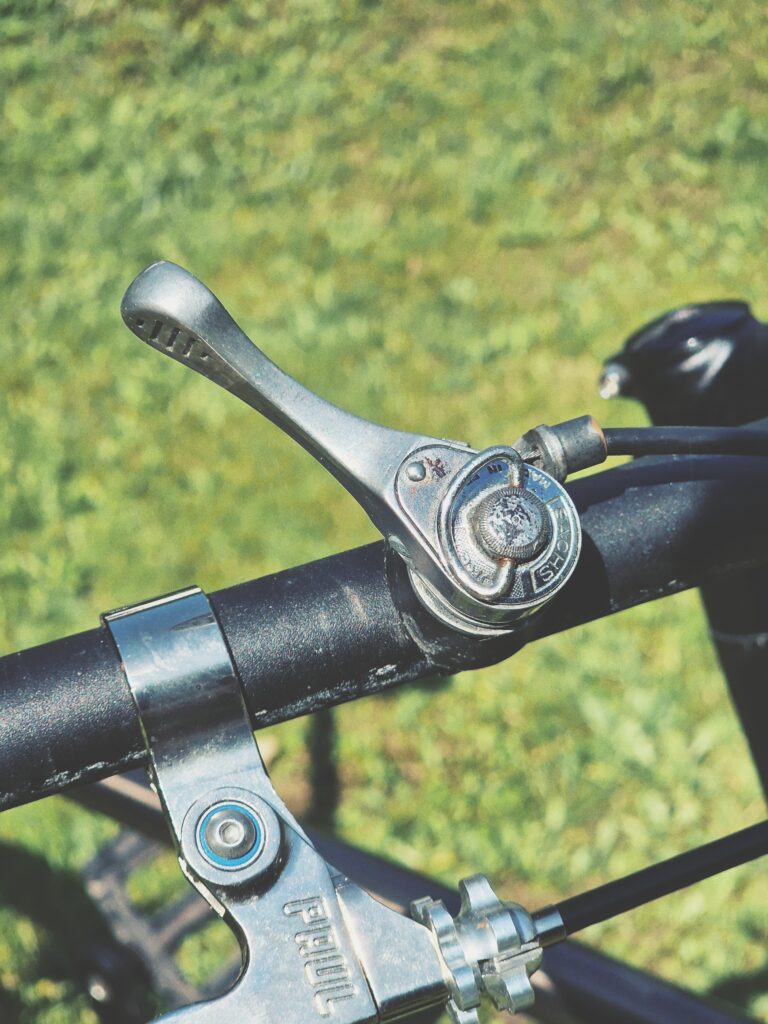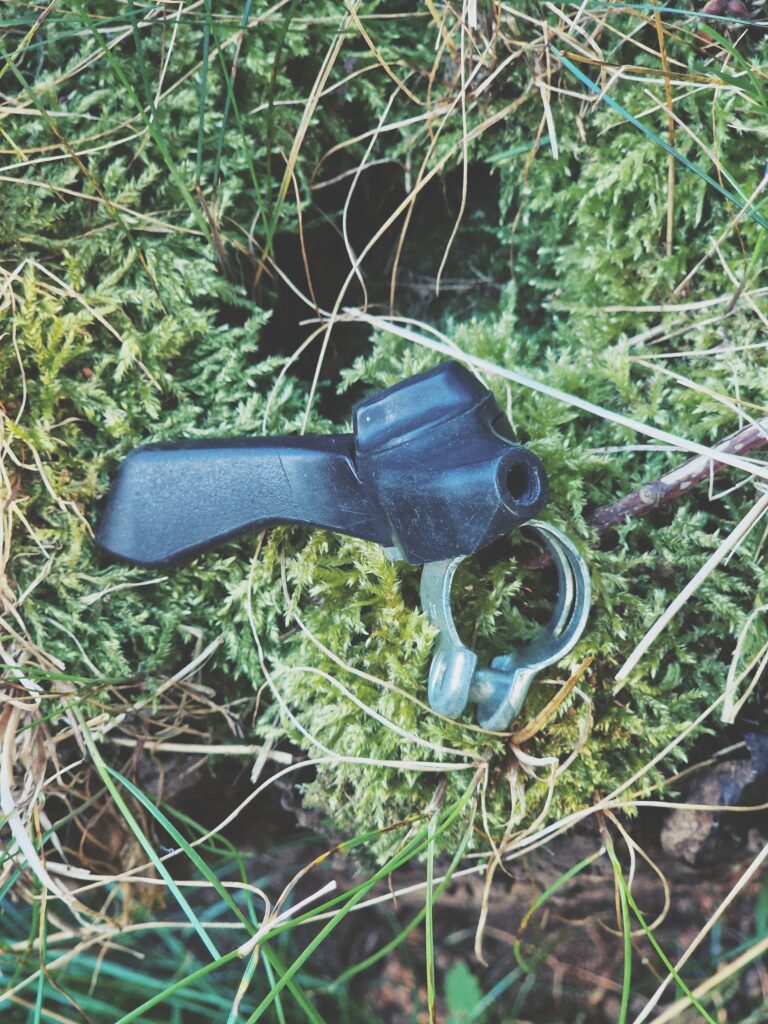I think the best way to describe the cycling world at the moment is that it is “coming full circle”. To put it simply, as bike technology progresses at rapid paces, there comes a time of reflection. This leads to a return to older standards and designs, primarily on a grassroots level. And sometimes, rarely, do we see the industry taking notes. Now, if you follow any of the current crop of “alt cycling” enthusiasts, you will know that one phenomena which seems to be facing a revival at the minute is the friction shifter.
Unveiling the relic
If you’ve ridden any road bikes from before and up to the late 80’s, chances are you’ve been fairly intimate with one of these little levers. And perhaps you’ve even cursed them to hell, having fever dreams of just riding fixed instead. Because prior to the infiltration of convenient indexed shifting in the late 80’s and early 90’s, that is the best you had to content yourself with. For those unaware of what friction shifting is, it is essentially shifting without the clicks. We know that as we pull the cable, the derailleur moves. In our indexed world, the shifter determines how much cable it should pull “per click”, to shift the chain unto the next cog. With a friction shifter you do the job yourself, you simply pull the lever until it shifts unto the correct cog and then the position is held by the friction plate.
To be completely honest, I think that in a world of fancy electronic shifted componentry, and narrow spaced 10/11/12 speed cassettes, it wouldn’t be far fetched to brand the humble friction shifter an archaic relic best suited for a spot in a hermetically sealed glass case. But yet here we are, in 2024, discussing it. Why so? Well, the main argument I see online is that it is the answer to the compatibility war. What I am referring to here is of course the compatibility cross brand and between various groupsets. This is something that has long been a problem of the cycling world, where for a long time the ability to mix and match to get something working together, in terms of 5/6/7/8/9 speed, was easily achieved provided you didn’t dare too much and tried the unholy SRAM/Shimano smoothie. Still to this day I know of people who are reluctant to venture into the realm of 10 speed – and 10 speed is by no means a younging.
Is there something to it all or is it just hipster nonsense? Time to experiment
So, is the problem of cross and backwards compatibility a good enough reason to do a spot of grave exhumation and bring out the old crusted friction shifters? I think so. I decided to explore this a while back, when I had a few bicycles I wanted to get working with a mix of componentry that frankly had some severe communication issues. One such example was using a 10-speed specific 105 derailleur on an eight speed freewheel. I opted for a relatively expensive, at least to me, Microshift thumbie. I did have some older ones laying about, but the build quality of the MicroShift ones looked a bit better and was informed that, if I were to shift clutched mech’s, I would need something that could hold well.


The setup was as simple as it could get. One of the beautiful things about a friction shifter is that it couldn’t care less about cable tension. This wasn’t so much an issue in the early days of indexing, by the way, but in modern times with the much narrower spaced cassettes with far more cogs, the adjustment becomes more important and it is far easier to get knocked out of whack. With a friction shifter, you clamp down that cable and go ride. If the cable is a wee bit on the slack slide, you just loose a bit of the lever range, but it’ll shift just fine. It did feel very rewarding to take something that, according to the spec sheets shouldn’t work together, and then see it shifting like butter. That said it does take a bit of getting used to, and you need to listen to the bike to find out when you’re perfectly in gear – but after a few rides the “positions” become almost second nature.
So far so good… But how well does it work the other way around?
Good first impressions really, and it made me want to explore a bit further. I obtained another MicroShift thumbie for my 11 speed 1x drivetrain, one of them proper dinner plate setups that I installed on my Cross Check a while back. I was quite attracted to the index/friction switch modes. Sadly, after running the 1×11 setup in friction mode for a bit, I quickly concluded that it wasn’t for me. My initial thoughts going into it was that the clutched mech would be the problem, as the clutch mechanism puts more tension on the whole derailleur and so there’s an increased risk of slippage using friction and it takes more force to actually shift it. But that wasn’t the problem. It actually shifted fine and was perfectly usable, but also more fiddly than my experience with the wider gapped 7/8 speed cassettes and freewheels. With the lesser speeds, due to the wider jumps, you get a better sense of when it is in gear and you have more room for error. The opposite was true for the 11 speed cassette, where a tiny bit of movement in the lever could cause it to jump too far and the risk of it sitting, sort of grinding on one of the neighbouring cogs, was higher. I still think it is an amazing little feature to have, to be able to go into friction mode, should you be in a situation where you are riding in horrendous conditions with a worn cable and do not have the time for any roadside tinkering. But I do not think friction in the realm of 10/11/12 makes for a very enjoyable experience. I have seen people on forums that swear it works just fine for them, so it could be a matter of getting used to it. I got put off as it did not feel as instinctively right.


On the flip side, I found that using these derailleurs designed for modern groupsets on older setups was perfect – if not preferable. I love modern GRX/Deore, aesthetically and function wise, especially the clutch feature is something I cherish now. Good luck finding a solid clutched mech that’ll work for your older pre-9 speed bikes. Well, I say that, but you could always get the Sunrace RDM900 which is a very low cost, wide range rear derailleur with a clutch designed for 9 speed. But anyway, that’s beside the point. With friction you open up a whole new world of experimentation, and I think it makes it worth it. Using my RX400 derailleur on a 7-speed freewheel works beautifully, using a 9 speed chain which gives sufficient clearance inside the mech cage while also offering sufficient width to prevent pinching the chain between the 7-speed cogs.


Have I been convinced? (Spoiler: yes, and I’ll list a few more reasons why..)
So, surely this would mean that I am officially Team Friction? (Please don’t get jerseys made, it’ll bring back the deep desire for me to obtain a Team Easy On jersey…. Danes will understand what I am on about)
The answer to the above is yes. I have been buying more and more friction shifters and have found that even the cheapest, nastiest, most plasticky ones do the job rather sufficiently. One of my critiques was going to be that the good ones are awfully expensive, and… they are… but the cheapo jobbies do the job OK too. Either way it is a small price to pay to have the freedom to make just about any setup work. The main benefit of modern friction shifters is that they have a bit more pull to them, as they were designed to cover the range of bigger cassettes. If you use an older one you may not be able to cover all the range. But that’s okay, your knees just get tougher.

And if you’re not yet convinced, let me remind you that friction shifters also solve another problem which I know many people have. As we know, the 1x drivetrains have pretty much taken over at this point and I think one of the big reasons for that is that most consumers find the front derailleur a bit of a fiddly fucker. I won’t disagree, because for a long time I refused to run anything but 1x – 1×6, 1×7, 1×8, 1×9 – you name it! And my reasoning was quite simply that I could not be bothered with a front derailleur. It always managed to grind, making a proper racket, and the supposed fix was these micro-adjustable shifters with a bunch of tiny indexed positions to trim the mech. I never liked that. Friction is the answer to that conundrum as well, as it makes for a very smooth shifting experience with a very accurate trimming function.
All in all, there’s so many benefits to friction shifting – particularly if you are running a mish mash of older 80’s and 90’s components and want to modernise a bit. There are of course some negatives, there’s a bigger learning curve until you get into the groove of it, and shifting under load does not feel as confidence inspiring as it does with indexing. You also do have to think more before you shift, and you will likely find yourself shifting less. This is good news for someone like me, who tends to mindlessly shift the more options I have. I don’t think friction shifting would appeal to cadence junkies who race and need everything to feel almost automated, but for touring and every day riding, there’s a bombproof reliability in a friction shifted setup. It does also give you a deeper connection to your bike, which may seem a bit like a bunch of wishy washy pocket philosophy, but I feel like I am truly in control of everything when I am friction shifting. I like having to hear and feel for when the chain is perfectly seated, and I enjoy doing an elegant sweep to my high gear as I reach the top of the hill. Very satisfying. Therefor I conclude, that not only is it perfect antidote to an increasedly convoluted and proprietary drivetrain industry, but is also gives you a newfound appreciation of just how simple and beautiful a mechanically shifted drivetrain really is. Just don’t make electronic friction shifters….

Leave a Reply